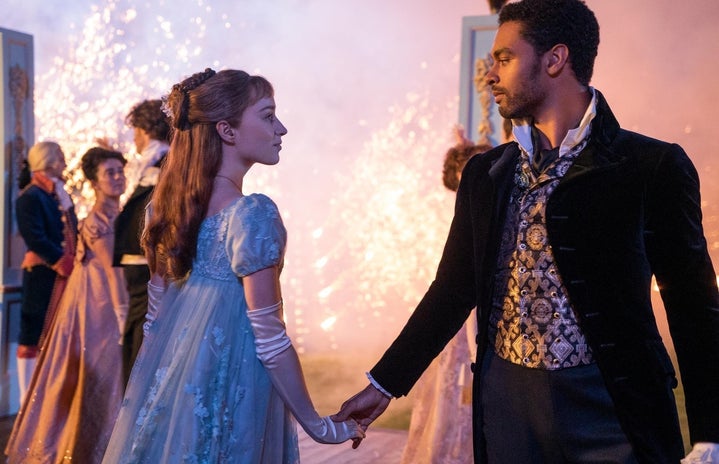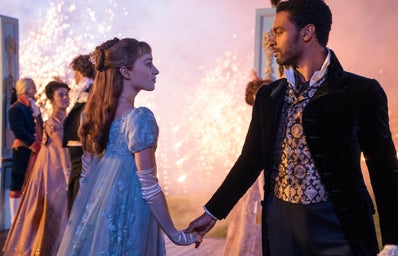It’s a Tuesday night, probably creeping towards the a.m. hours. You’re lying in bed with the lights off, swiping through an endless sea of self-proclaimed “biggest fans” of The Office (BFFR, there can only be one), and guys whose hottest take is liking pineapple on pizza. Before you know it, it’s half past two, and with an exhausted right thumb and dry eyes, you finally put down your phone.
As you fall asleep, you can’t help but curse (insert your dating app of choice) and half-heartedly wonder, Why couldn’t I have been born in another generation?
In The Curious History of Dating: From Jane Austen to Tinder (Little-Brown, 2017), British journalist Nichi Hodgson gives readers a tongue-in-cheek crash course of these (not-so) simpler times. With each chapter dedicated to a different time period, the 234-page book spans over 300 years. Beginning with the “posting for a wife” newspaper ads and subliminal flirting via fontage fan (fanning quickly = “I’m engaged”) of the late 17th century, Hodgson details sex and love, all the way to the online dating boom, Bluetooth operated vibrators, and blurred gender norms of the 2010s.
Hodgson gives a comprehensive and engaging history of dating peppered with modern allusions and Brit-Wit. The verdict? Dating in the past isn’t different after all. Before there was ghosting, swiping, and matching, there were calling cards, bundling (essentially dry-humping), and matching (though not through an iPhone). Hodgson’s readers soon discover that the euphemisms and abbreviations of the sex and dating world today are just reinventions of their predecessors. Today, one may hint to a potential partner that they’re DTF (down to … you know), but in 1930’s England, men in pubs pondered a woman’s sexual availability, wondering if she was TBH (“to be had”).
For a book that explores archaic dating customs, The Curious History of Dating is refreshingly inclusive. Hodgson herself is a sex-positive bisexual, who has openly written and spoken about her identity. The Curious History is her second book, her first being Bound to You, a memoir about her time working as a dominatrix.
In nearly every chapter, Hodgson spotlights the sex and dating experiences of LBGTQ+ people in that era. In the chapter “The Twenties,” Hodgson explains how sexual acts between women were criminalized legally in 1921, after England passed the Criminal Law Amendment Bill. Hodgson tells the story of “the most famous lesbian of the period,” writer Vita Sackville-West. Vita was married to a gay man, writer and diplomat Harold Nicholson, while she pursued a love affair with another woman, Violet Keppel. Hodgson details their relationship: how Vita cross-dressed as her male alter-ego, Julian, while spending summer 1918 in Cornwall with Violet. How Harold described Violet’s will as “like a jellyfish on cocaine” when she encountered Vita. How the two women remained in contact via letter for forty years, even after their affair ended.
Hodgson makes a point to tell these often overlooked LGBT+ stories. Chapter 12 is titled “The Eighties: Aids and Raves.” Obviously she discusses big Straight News: “THE Royal Wedding of the Century,” dating advice books written to help a woman catch a man, and popular dating shows like Blind Date, which ran until 2003. Hodgson cautiously weaves in a summary of the AIDS crisis — not shying from the widespread death and mistreatment of the time — between lighter topics: Cosmopolitan articles, the rise of the androgynous pop-star, and video dating (a briefly lived fad; Hodgson recommends a YouTube search to see how truly awkward it was). The Eighties chapter, though a bit rushed, tells a story that honors those impacted by the AIDS crisis.
In The Curious History of Dating, Hodgson hits the ground running, with an opening line spoofing that of Pride and Prejudice. “In 1786, it was a truth universally acknowledged that a single man in possession of a large fortune could find a wife via a Lonely Hearts ad, published in The Times newspaper,” she writes. This one liner gets Hodgson some laughs from Austen buffs, and segues into 18th Century Dating 101. However, with the lack of a proper introduction and conclusion, The Curious History of Dating feels a bit unmoored. Readers are thrown headfirst into the subject matter, and the final chapter is a hasty summary of 300 years of material wedged between the cracks of the current state of dating, which deserves its own standalone chapter.
If you are able to look beyond the occasional millennial comparison (“It may sound like a phrase redolent of Beyoncé feminism, but ‘self-made girls’ was the expression of the day,” Hodgson writes of the Edwardian era), Hodgson’s writing is clear and clever. The book is generally thorough, though nothing groundbreaking or highbrow. And even though “The Curious History” was published in 2017, a whole lot has changed in the seven years of the lightning-speed Internet age since then. Hodgson lists a slew of dating apps, many of which are now defunct or lack cultural relevance. The increasingly-popular app Hinge, not even mentioned by Hodgson, was acquired by Match Group in 2018. Match Group, who owns match.com, Tinder, Hinge, and other online dating sites, is currently facing a class-action lawsuit, accused of exploiting users via their monetized gamification of the search for love. This isn’t Hodgson’s fault (I doubt a 40-year-old British journalist is secretly harboring a time machine), but the book ends at a point where things were really getting interesting — pre-Hinge, pre-lawsuit, pre-pandemic. Maybe someday Hodgson will release a second edition, featuring her take on dating in the 2020s.
The Curious History of Dating is a thoroughly researched, playfully executed read. By the end, I found myself with a back pocket full of flirty history facts to pull from on a doomed Tinder date. Period romance junkies, history buffs, and online dating aficionados and/or victims will find Hodgson’s writing enjoyable and easy to digest.
Can’t get enough of HC UMass Amherst? Be sure to follow us on Instagram, listen to us on Spotify, like us on Facebook, and read our latest Tweets!




